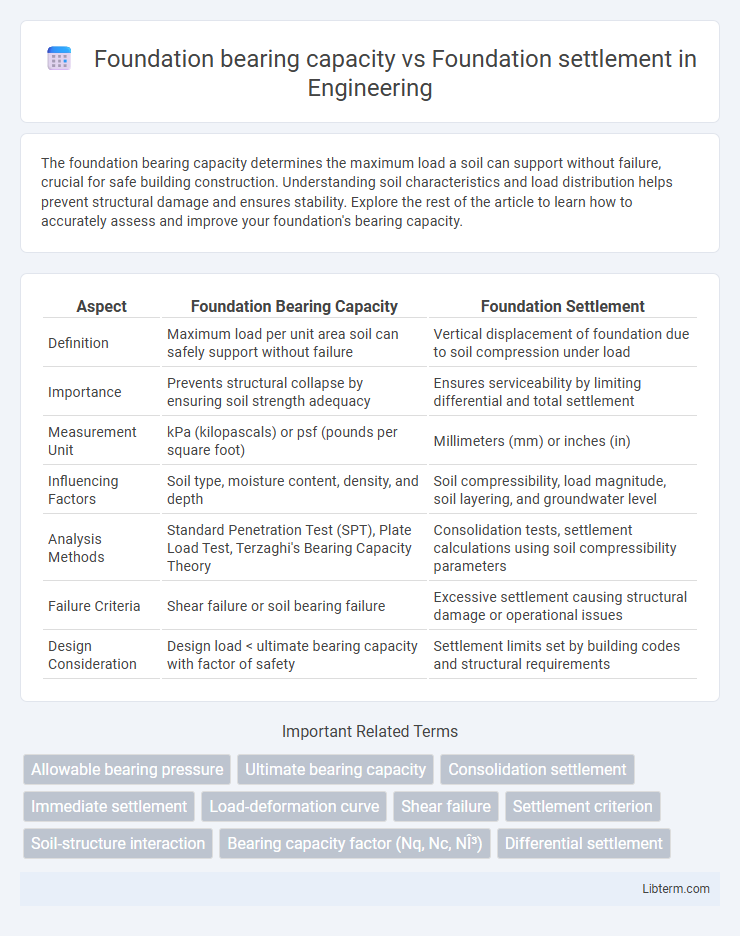The foundation bearing capacity determines the maximum load a soil can support without failure, crucial for safe building construction. Understanding soil characteristics and load distribution helps prevent structural damage and ensures stability. Explore the rest of the article to learn how to accurately assess and improve your foundation's bearing capacity.
Table of Comparison
| Aspect | Foundation Bearing Capacity | Foundation Settlement |
|---|---|---|
| Definition | Maximum load per unit area soil can safely support without failure | Vertical displacement of foundation due to soil compression under load |
| Importance | Prevents structural collapse by ensuring soil strength adequacy | Ensures serviceability by limiting differential and total settlement |
| Measurement Unit | kPa (kilopascals) or psf (pounds per square foot) | Millimeters (mm) or inches (in) |
| Influencing Factors | Soil type, moisture content, density, and depth | Soil compressibility, load magnitude, soil layering, and groundwater level |
| Analysis Methods | Standard Penetration Test (SPT), Plate Load Test, Terzaghi's Bearing Capacity Theory | Consolidation tests, settlement calculations using soil compressibility parameters |
| Failure Criteria | Shear failure or soil bearing failure | Excessive settlement causing structural damage or operational issues |
| Design Consideration | Design load < ultimate bearing capacity with factor of safety | Settlement limits set by building codes and structural requirements |
Introduction to Foundation Bearing Capacity and Settlement
Foundation bearing capacity refers to the maximum load per unit area that soil can safely support without failure, ensuring structural stability. Foundation settlement describes the vertical displacement of a structure due to soil compression under load, which can affect building integrity over time. Understanding both bearing capacity and settlement is crucial for designing foundations that prevent excessive sinking and uneven structural deformation.
Definition and Importance of Bearing Capacity
Foundation bearing capacity refers to the maximum load per unit area that soil can support without experiencing shear failure, while foundation settlement denotes the vertical displacement of the foundation under load. Bearing capacity is crucial for ensuring structural stability, as it helps prevent foundation failure by allowing engineers to design foundations that stay within safe load limits. Understanding bearing capacity also minimizes excessive settlement, which can lead to structural damage and serviceability issues.
Understanding Foundation Settlement
Foundation settlement refers to the vertical displacement or sinking of a structure's foundation due to soil compression or load distribution changes. Understanding settlement involves assessing soil characteristics, load intensity, and duration to predict potential risks such as differential settlement, which can cause structural damage. Accurate evaluation of foundation bearing capacity ensures the soil can support the imposed loads while minimizing excessive settlement that jeopardizes stability and serviceability.
Key Factors Influencing Bearing Capacity
Foundation bearing capacity depends on soil type, moisture content, and load distribution, which determine the soil's ability to support structural loads without failure. Key factors influencing bearing capacity include soil shear strength, depth and width of the foundation, and groundwater conditions that affect soil consistency and stability. Foundation settlement occurs when the soil compresses under load, influenced by soil compressibility and consolidation characteristics, but proper assessment of bearing capacity ensures minimal settlement and structural integrity.
Main Causes of Foundation Settlement
Foundation bearing capacity defines the maximum load a soil can support without failure, while foundation settlement refers to the vertical displacement due to soil compression under load. Main causes of foundation settlement include soil consolidation under sustained loads, shrinkage of clay soils during dry conditions, and differential settlement caused by non-uniform soil properties or varying load distributions. Excessive settlement threatens structural integrity by causing uneven floors, cracks, and misalignment in buildings and infrastructure.
Types of Foundations and Their Bearing Behavior
Shallow foundations such as spread footings and mat foundations generally exhibit high bearing capacity but are more susceptible to larger settlements, especially on compressible soils. Deep foundations including piles and drilled shafts transfer loads to deeper, more stable soil layers or bedrock, achieving higher bearing capacity with minimal settlement. Understanding the bearing behavior of different foundation types is crucial for optimizing structural stability and preventing differential settlement risks.
Comparative Analysis: Bearing Capacity vs Settlement
Foundation bearing capacity determines the maximum load that soil can support without failure, while foundation settlement refers to the vertical displacement of the foundation under load. High bearing capacity ensures structural stability, but excessive settlement can cause structural damage even if bearing capacity is adequate. Comparative analysis highlights that optimal foundation design requires a balance between sufficient bearing capacity and controlled settlement to prevent structural distress.
Methods to Improve Bearing Capacity and Limit Settlement
Improving foundation bearing capacity involves techniques such as soil stabilization using lime or cement, installation of deep foundations like piles or drilled shafts, and ground improvement methods including vibro-compaction and stone columns. To limit foundation settlement, engineers employ preloading with surcharge fills, use geosynthetics for soil reinforcement, and implement controlled dewatering to consolidate compressible soils. These methods ensure enhanced soil strength and reduced differential settlement, promoting structural stability and longevity.
Field Testing and Monitoring for Bearing Capacity and Settlement
Field testing methods such as Standard Penetration Test (SPT) and Plate Load Test provide critical data for evaluating foundation bearing capacity, ensuring the soil can support structural loads without failure. Settlement monitoring employs precise instruments like settlement plates and inclinometers to track vertical and lateral movements over time, detecting potential risks to structural integrity. Integrating real-time data from field tests and settlement monitoring enhances the accuracy of foundation performance assessments and informs necessary design adjustments.
Conclusion: Balancing Bearing Capacity and Settlement in Design
Balancing foundation bearing capacity and foundation settlement is essential for ensuring structural stability and longevity. Adequate bearing capacity prevents shear failure of the soil, while controlling settlement avoids excessive differential displacement that can damage the superstructure. Optimizing design requires thorough geotechnical investigation and foundation analysis to achieve a safe, cost-effective balance between load-bearing strength and permissible settlement limits.
Foundation bearing capacity Infographic

 libterm.com
libterm.com